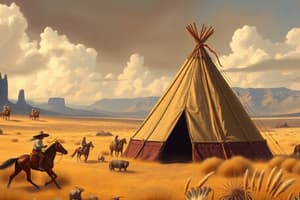Podcast
Questions and Answers
Which of the following statements accurately reflects the perspective on battles in the American West during this period?
Which of the following statements accurately reflects the perspective on battles in the American West during this period?
- The term "battle" was used to describe all engagements, but only white victories were considered legitimate.
- The term "battle" was always applied to a Native American victory, while "massacre" was used for white victories.
- Both sides used the term "battle" to describe the conflict, regardless of the outcome.
- Native American successes were often referred to as "massacres," while white victories were labeled as "battles." (correct)
What was the primary objective of the Grange Movement in its initial stages?
What was the primary objective of the Grange Movement in its initial stages?
- To create social spaces and build community amongst isolated farmers. (correct)
- To fight against the influence of railroads and manufacturers on agricultural prices.
- To organize a network of farmers to lobby for government subsidies and policies.
- To establish an alliance with farmers' groups in the eastern United States to gain support and political power.
Which of the following groups did the Farmers' Alliance fail to include in its efforts, ultimately weakening its support?
Which of the following groups did the Farmers' Alliance fail to include in its efforts, ultimately weakening its support?
- Wealthy landowners with large-scale agricultural operations.
- Independent farmers who relied on seasonal crops.
- Small landowners with limited resources.
- Landless tenant farmers, sharecroppers, and farmworkers. (correct)
What was one of the significant reasons for the decline of Plains Indian populations in the late 19th Century?
What was one of the significant reasons for the decline of Plains Indian populations in the late 19th Century?
What was the main objective of the Farmers' Alliance in its fight against monopolies?
What was the main objective of the Farmers' Alliance in its fight against monopolies?
What does Chief Joseph believe is at the root of all conflict between Native Americans and the US Government?
What does Chief Joseph believe is at the root of all conflict between Native Americans and the US Government?
How did the government attempt to justify the land grabs from Native Americans?
How did the government attempt to justify the land grabs from Native Americans?
What was the primary purpose of the Dawes Severalty Act of 1887?
What was the primary purpose of the Dawes Severalty Act of 1887?
How does Helen Hunt Jackson's book, A Century of Dishonor , contribute to the understanding of the conflict between Native Americans and the US Government?
How does Helen Hunt Jackson's book, A Century of Dishonor , contribute to the understanding of the conflict between Native Americans and the US Government?
Which of these is a key difference between Chief Joseph and Sitting Bull?
Which of these is a key difference between Chief Joseph and Sitting Bull?
What was the primary motivation for Geronimo's raids on white settlers in the Southwest?
What was the primary motivation for Geronimo's raids on white settlers in the Southwest?
Which perspective did Chief Joseph espouse regarding Native American rights?
Which perspective did Chief Joseph espouse regarding Native American rights?
What is the main theme conveyed in the Native Chiefs section of the reading?
What is the main theme conveyed in the Native Chiefs section of the reading?
Which of the following factors contributed to the rapid development of the West?
Which of the following factors contributed to the rapid development of the West?
Which of the following was a direct result of the discovery of the Comstock Lode?
Which of the following was a direct result of the discovery of the Comstock Lode?
What was a common problem faced by ranchers in the West before the Transcontinental Railroad was built?
What was a common problem faced by ranchers in the West before the Transcontinental Railroad was built?
How did the development of bonanza farms impact smaller farmers?
How did the development of bonanza farms impact smaller farmers?
What was a central goal behind the Homestead Act of 1862?
What was a central goal behind the Homestead Act of 1862?
Which of the following groups was most likely to support the policies advocated by the populists?
Which of the following groups was most likely to support the policies advocated by the populists?
The phrase “Pike’s Peak or Bust” refers to:
The phrase “Pike’s Peak or Bust” refers to:
Which of the following economic policies was favored by the debtors?
Which of the following economic policies was favored by the debtors?
Flashcards
Custer’s Last Stand
Custer’s Last Stand
A battle where Custer's 400 soldiers were defeated by Crazy Horse & Sitting Bull's 2500 warriors at Little Bighorn.
Ghost Dance
Ghost Dance
A religious movement among the Dakota Sioux aiming to restore their lost way of life.
Grange Movement
Grange Movement
An organization aimed at improving farmers' lives through social activities and cooperative efforts.
Farmers’ Alliance
Farmers’ Alliance
Signup and view all the flashcards
Populists
Populists
Signup and view all the flashcards
Chief Joseph
Chief Joseph
Signup and view all the flashcards
Sitting Bull
Sitting Bull
Signup and view all the flashcards
Geronimo
Geronimo
Signup and view all the flashcards
A Century of Dishonor
A Century of Dishonor
Signup and view all the flashcards
Dawes Severalty Act
Dawes Severalty Act
Signup and view all the flashcards
Plains Indians' Surrender
Plains Indians' Surrender
Signup and view all the flashcards
Great Spirit Chief
Great Spirit Chief
Signup and view all the flashcards
Broken Promises
Broken Promises
Signup and view all the flashcards
Supporters of Economic Reform
Supporters of Economic Reform
Signup and view all the flashcards
Opponents to Economic Reform
Opponents to Economic Reform
Signup and view all the flashcards
Gold Discovery in Colorado
Gold Discovery in Colorado
Signup and view all the flashcards
Comstock Lode
Comstock Lode
Signup and view all the flashcards
Boomtowns
Boomtowns
Signup and view all the flashcards
Homestead Act (1862)
Homestead Act (1862)
Signup and view all the flashcards
Sodbusters
Sodbusters
Signup and view all the flashcards
Oklahoma Land Rush (1889)
Oklahoma Land Rush (1889)
Signup and view all the flashcards
Study Notes
The West (1865-1900)
- The period from 1865 to 1900 saw significant westward expansion in the United States, driven by factors like railroad construction, mineral discoveries, and government policies.
Native American Conflicts
- After the Civil War, Plains Indians surrendered land expecting protection and supplies, but this was often broken.
- Helen Hunt Jackson's "A Century of Dishonor" detailed government abuse, broken promises, and forced removals.
- The Dawes Severalty Act (1887) aimed to assimilate Native Americans by dissolving tribes, eliminating tribal land ownership, and promoting individual land ownership. This often led to dispossession and cultural disruption.
- Many Native American leaders, like Sitting Bull, Geronimo, and Chief Joseph, resisted these policies and fought for their rights and traditional way of life.
Battles on the Plains
- Conflicts between settlers and Native Americans resulted in numerous battles, including the Battle of Little Bighorn (Custer's Last Stand), and the Battle of Wounded Knee.
- The near extinction of the buffalo, coupled with railroad expansion, made it easier to displace Native American populations.
- Buffalo Soldiers, a significant portion of the frontier troops, played a critical military role in westward expansion, but were disproportionately black.
Wanton Destruction of Buffalo
- The rapid expansion and settlement of the West led to the ruthless killing of bison as settlers and railroad companies sought land and resources.
- This had a significant impact on the Native American way of life, which depended on the bison for food, clothing, and shelter.
Unrest in the West
- Farmers' movements were initiated to address the issues of railroad and manufacturing monopolies leading to increasing costs and crushing debt for the farmers.
- The Grange Movement and Farmers' Alliance were both important responses to the struggling farmers in the West.
- The goals of these groups shifted towards collective action to combat the challenging plight of the farmers by promoting cooperative buying and selling to reduce the grip of the corporations, and offering relief for indebted farmers.
- Ultimately, the goals foreshadowed the Populist movement.
The Populists (1892)
- The Populist party emerged as a response to the struggles of farmers and workers in the West, advocating for policies like nationalizing railroads, a graduated income tax, and the free coinage of silver. This was intended to increase the money supply and lower debt.
- While they saw success in limited places, their attempts to unify the struggling populations were hampered, ironically, by racial division in the South, which was their core market for support.
- Populists won seats in Congress, garnering over a million votes for presidential candidate James B. Weaver, signifying their importance and popularity in the region.
- Their opponents, Republican industrialists, were known (derisively) as "Gold Bugs".
The Mining Industry
- Gold and other mineral discoveries in Colorado led to westward migration and booms in mining towns.
- The Comstock Lode in Nevada, further fueled westward expansion, as it provided a quick path to statehood.
- Boomtowns (also known as Helldorados) were characterized by lawlessness.
- The mining industry helped finance the Civil War and the building of railroads.
The Meat Industry
- Ranching developed in response to the growing demand for meat.
- Long cattle drives allowed ranchers to move herds to railroad depots in the East.
- These drives were made difficult by harsh weather conditions and encroachment from homesteaders who were fencing off land.
Agriculture
- The Homestead Act (1862) encouraged westward migration through land grants.
- Initially, the plan involved selling public land for revenue; then, land plots were given away to spur the growth of the population.
- Settlers struggled with issues like harsh weather, lack of resources, and soil conditions.
- The use of mechanization, such as barbed wire fences, led to bonanza farms. Large farm operations developed, often displacing smaller farmers who were unable to compete.
- Oklahoma was opened for settlement, resulting in a large influx of settlers and leading to the boom of Oklahoma.
- Federally funded irrigation projects were important to the development of agriculture in the West.
Studying That Suits You
Use AI to generate personalized quizzes and flashcards to suit your learning preferences.




